Scotchman Peak in Clark Fork, Idaho, steadfastly remains one of the most popular hikes in Northern Idaho. This famous peak is a boon for hikers who crave a hearty workout and breathtaking views. Visitors and locals alike trudge their way to the top for its unparalleled viewpoints of the Clark Fork valley, Lake Pend Oreille, and the Cabinet Mountains. The hike also offers the fun bonus of photographing the herd of mountain goats that live at the top.
My husband and I have always been outdoorsy, spending our younger years hiking and traveling our way around the world, but with the birth of our son, we had cooled down on high-impact hiking. And by cooled down, I mean completely stopped.
Instead, we opted to take our young son when we went outdoors and stick to short hikes with minimal elevation gain—an excellent choice for our budding outdoorsman but a neglectful choice for our bodies, no doubt.
Would we be able to handle Scotchman Peak, the highest peak in Bonner County?
Perched high at 7029 feet, the peak requires an 8-mile out-and-back hike that gains 3700 feet over the course of four miles. In other words, you’re going to feel the burn.
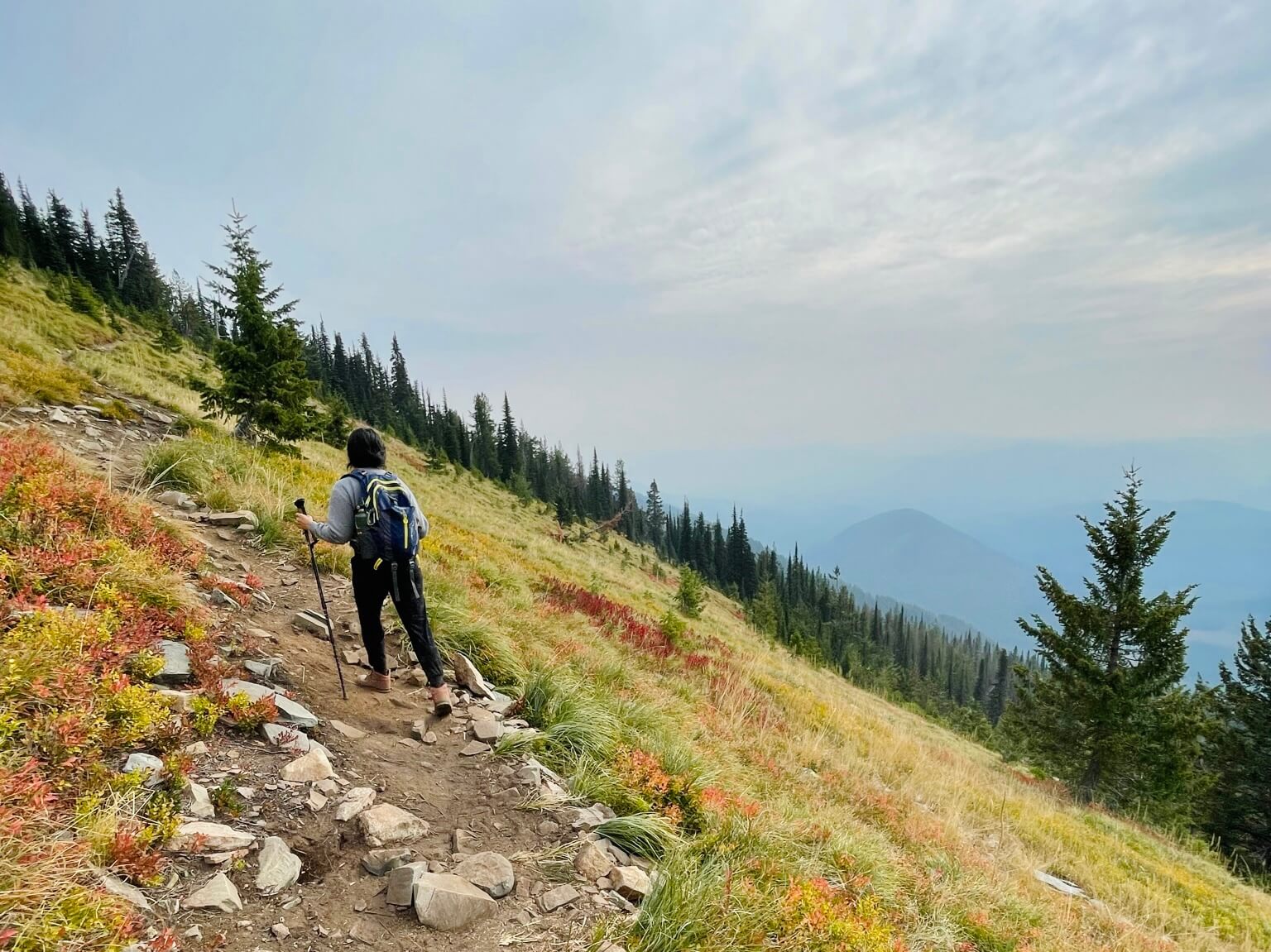
The Prep
For weeks before the hike, I would scour through trail reports to see if anyone would declassify the hike from difficult to “not that bad.” No one did. Everyone was quite frank in their assessment that it was a constant uphill trek that rightly earned its rating as difficult.
With a challenging hike looming in the distance and an unconditioned body, I felt there was only one choice: a daily regimen of squats, lunges, and burpees. I tried to get my husband on board with my new “Scotchman Peak fitness plan,” but he was a no-go. So alone, I squatted, lunged, and burpeed in hopes of getting my body ready for the hike.
Hiking Day
While popular wisdom says to get on the trail as early as possible, life with a little one doesn’t always make that possible. After school drop off, we managed to get to the trail by 10 AM, a later start for sure, but still doable if we hustled. The hike is an all-day hike and, on average, takes about 6.5 hours to complete.
The trail starts out forested with fir and cedar trees offering a shady respite from the morning sun. The beginning is steeper, with a series of switchbacks that will get your heart pumping and your legs fired up. Because it’s a marathon of a hike, it’s best to consider this part the warm-up.
The trail is well-maintained and easy to follow, but there are talus fields and loose shale. We had hiking sticks which came in handy when navigating the bigger rocks.
Once the trail opens up, you’ll get your first sweeping lookout of Lake Pend Oreille and the mountains. Having lived in Sandpoint for several years, I’m no stranger to that particular view, and yet it never ceases to amaze me. Idaho has no end of glorious lakes and rivers, but Lake Pend Oreille is something special.
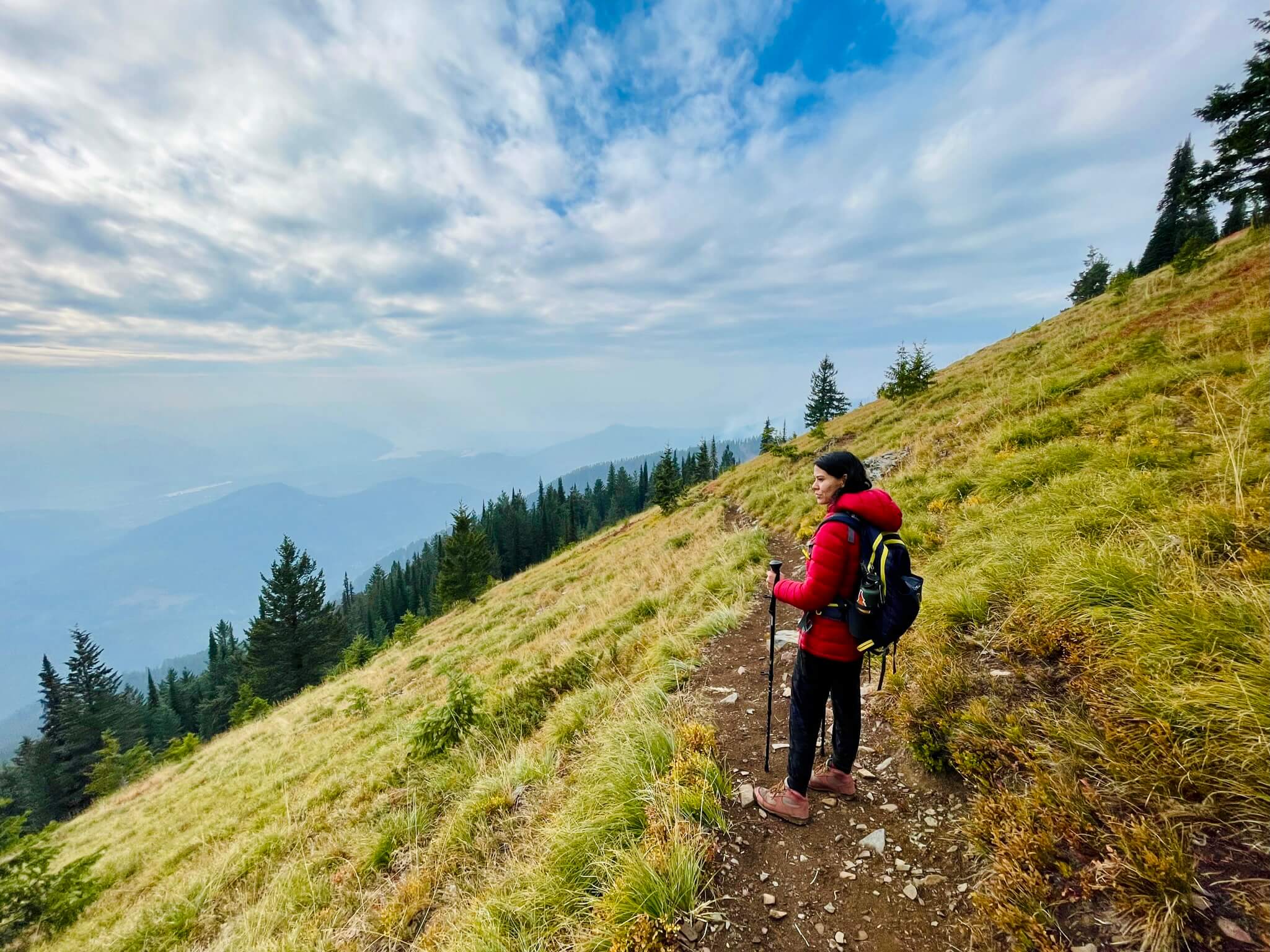
Midway to the top, we stopped to take a breather for lunch and enjoy the views. Unfortunately, there was a fire in the area, so it was hazy the day we hiked, but even with the smoke obscuring the lake, it was still peaceful to look out at Northern Idaho’s majestic mountain peaks.
The second half of the hike was the most beautiful, with cascading meadows ablaze with red, dried-out huckleberry patches. If you’re hiking in the summer, pluck off a few and enjoy Idaho’s state fruit. While the ascent might not be as steep the higher you get, it’s still a decent incline to the top, so we took it slow and steady. The last thing we needed was to burn out too soon.
The last stretch of the hike, it started to rain, and looming grey clouds were making me a little queasy. We continued on and climbed up a steep talus field to get to the first peak. It’s a false peak, and many people are fooled into thinking they’ve reached the top. You haven’t. The easiest way to tell is by scanning the area for the highest point. If you see a higher peak…you haven’t reached the top. From the first false peak, it’s a little under a half mile more to the top. You’ll need to cross talus, craggy rock, and most likely contend with the local mountain goats.
The herd lives there year-round and has become accustomed to human presence. That being said, keeping the required 100 feet of distance from the mountain goats is essential. They are curious (especially the kids!), and being the salt lovers they are, they might try to approach you and lick your sweaty bodies or gear. Make some noise to shoo them away, and keep your distance so the mountain can stay open for all to enjoy.
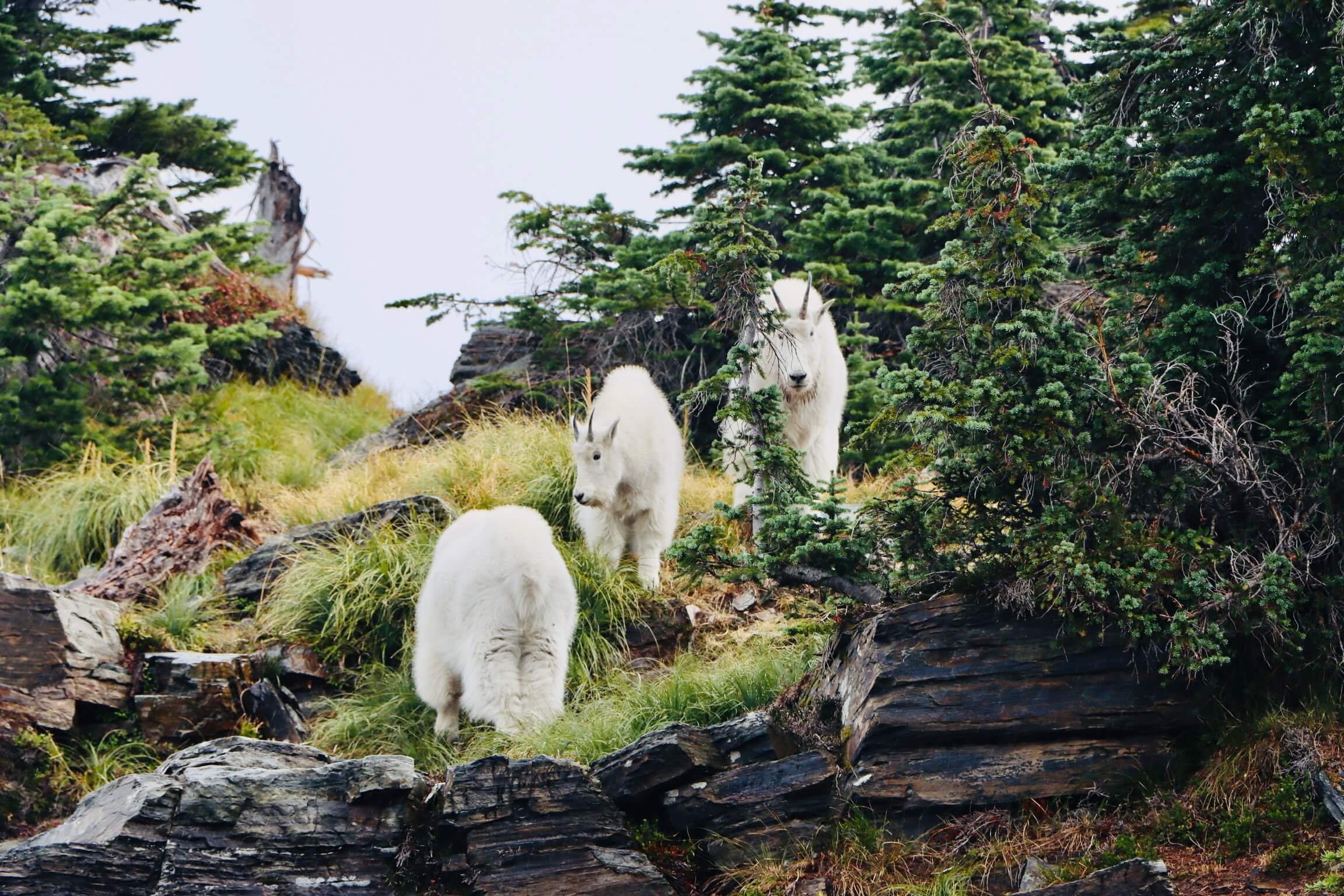
We were lucky to see four mountain goats that day. A kid and three adults were munching away right smack in the middle of the trail. We were exhilarated to have reached the false peak, but the thought of impending lightning, shooing away the mountain goats, and getting to aftercare pick-up was gnawing at me. Continue on the extra half mile or take some chances?
I’ve been in the outdoors enough to know taking chances is never a good choice.
So we headed down, proud of ourselves for accomplishing our first big hike since having our son. This is when our hiking poles really came in handy! While hiking up is a true test of endurance and strength, hiking down can be just as hard and feel brutal on the joints. For anyone looking to protect their knees, bring a pair of hiking poles to help you.
The hike was indeed a challenge, but I’m happy to say these two parents happily conquered the mountain. Was it all those lunges? Lunges or not, Scotchman Peak is a bucket list hike in Northern Idaho that everyone should try at least once.
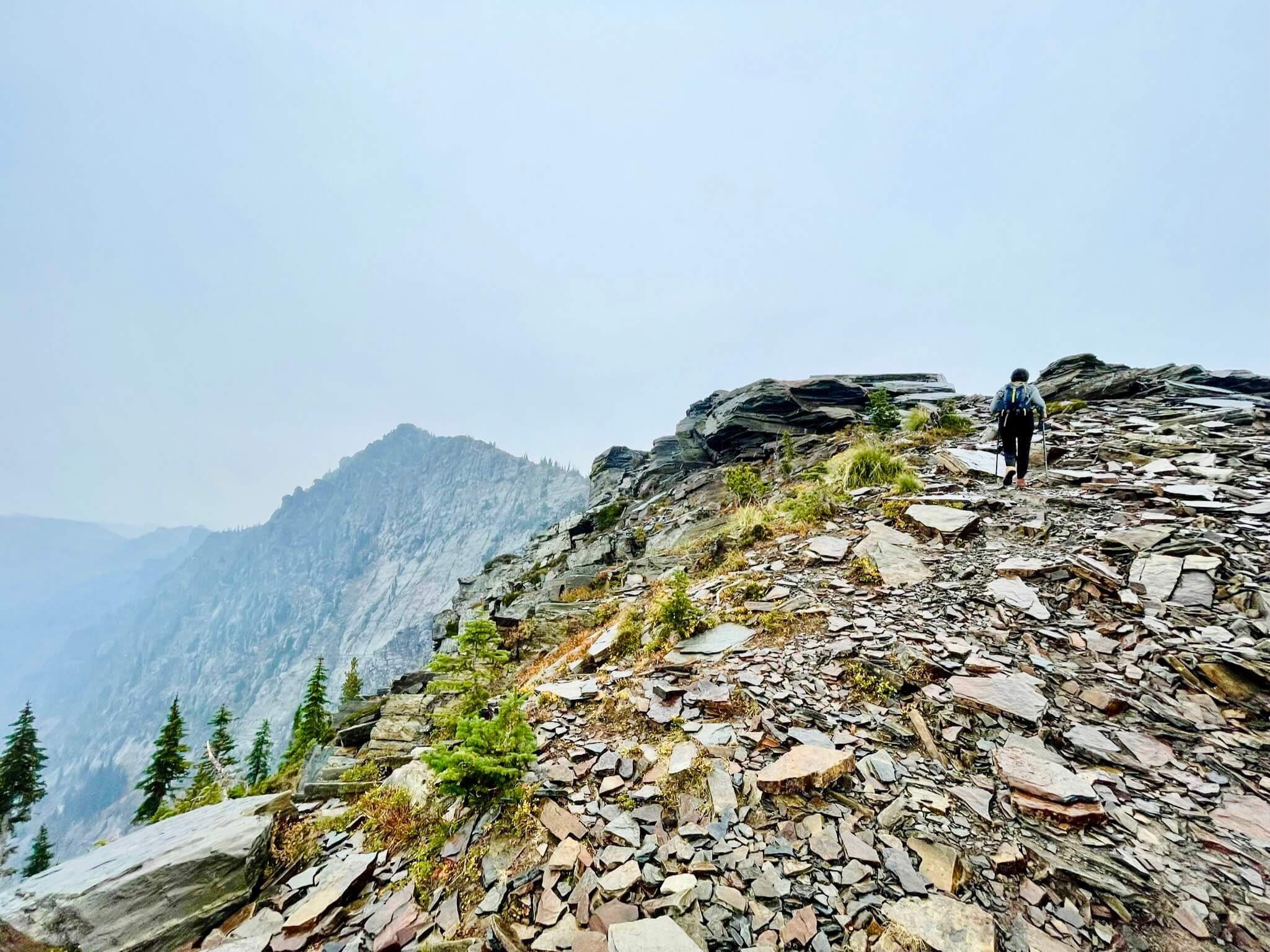
Getting There
Driving to the trailhead can be tricky, especially if you rely on GPS (don’t rely on GPS!). We used the written out directions on All Trails and were able to get there without a problem. There will be no signs pointing you to “Scotchman Peak Trailhead,” but there will be a couple of signs guiding you to trail number #65. The ideal car is a high-clearance vehicle that can handle bumps and rutted-out roads.
When To Go
Unless you are experienced in hiking in snowy conditions, the safest and most enjoyable time to hike the trail is from mid-June to mid-October. We went in October, and the fall colors, less crowded trail, and cool weather made for a spectacular hike. The downside to hiking the trail in the fall is smoke from nearby fires and fog from cooler weather can significantly hinder the view.
If hiking the trail in the summer months, get out early to beat the crowds and to avoid the hot midday sun.
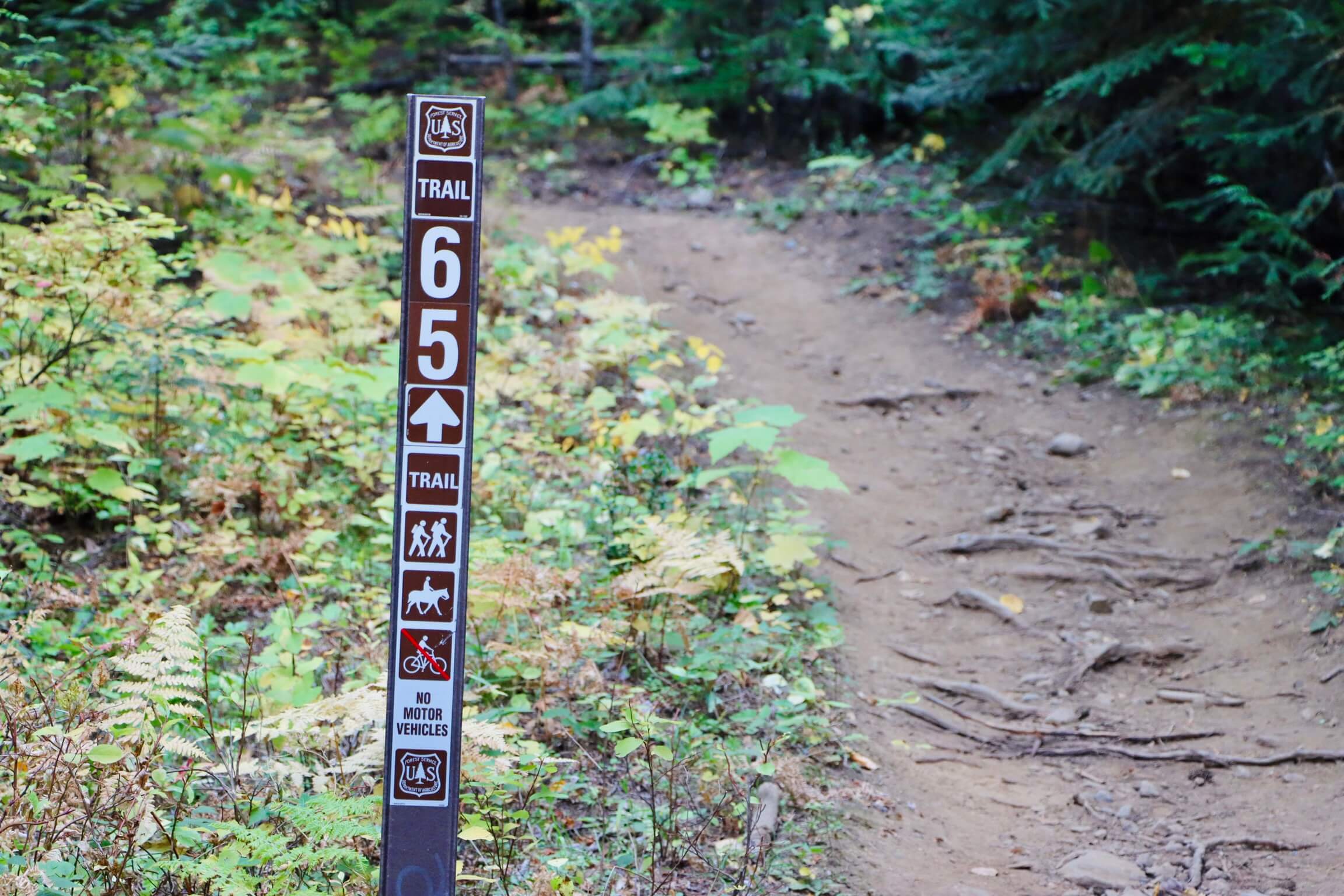
What To Bring
Prep is everything when it comes to more strenuous hikes. Here’s a short list of what to bring with you:
- A daypack with lunch, water, and salty snacks. Bring more than you think you need.
- The Cabinet Mountains are home to grizzly bears, so bring bear spray and have it readily accessible.
- Layers for the windier and cooler conditions at the top.
- Packable rain jacket if rain is in the forecast.
- Hiking sticks
- A bag to put ALL your trash into
Last Thoughts
Scotchman Peak Hike is a beast of a hike that will leave you feeling accomplished and more than a little sore afterward. It’s completely worth it for the bragging rights! Friends of Scotchman Peaks is a fantastic organization that offers information on the wilderness area as well as as guided hikes throughout the year.
Feature image credited to Live a Wilder Life.
Christina Grance and Brad Benoit are the wife/husband duo behind the adventure travel blog, Live A Wilder Life. Former full-time travelers turned part time nomads, they live with their wild son and an ornery cat in North Idaho where they spend every second they can dreaming up their next big trip. They specialize in outdoor travel for the everyday adventurer and love helping people to plan or discover their next trip. You can read their travel guides and tips at their travel website or follow along @liveawilderlife.
Published on September 17, 2024
